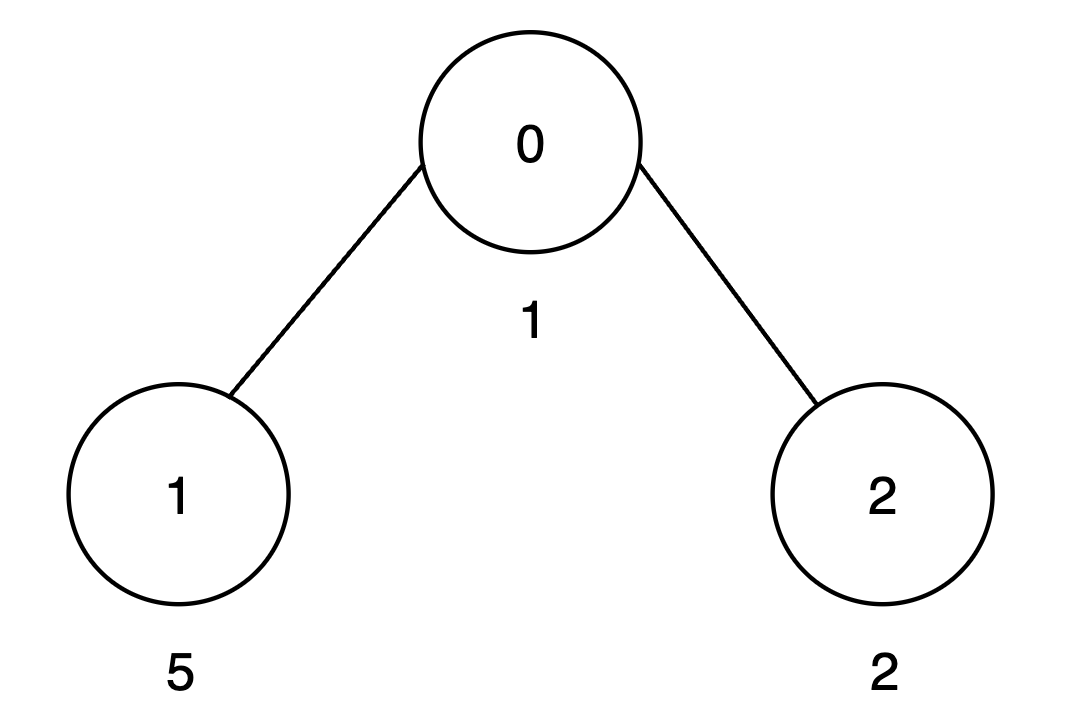LeetCode-in-Java
3575. Maximum Good Subtree Score
Hard
You are given an undirected tree rooted at node 0 with n nodes numbered from 0 to n - 1. Each node i has an integer value vals[i], and its parent is given by par[i].
A subset of nodes within the subtree of a node is called good if every digit from 0 to 9 appears at most once in the decimal representation of the values of the selected nodes.
The score of a good subset is the sum of the values of its nodes.
Define an array maxScore of length n, where maxScore[u] represents the maximum possible sum of values of a good subset of nodes that belong to the subtree rooted at node u, including u itself and all its descendants.
Return the sum of all values in maxScore.
Since the answer may be large, return it modulo 109 + 7.
Example 1:
Input: vals = [2,3], par = [-1,0]
Output: 8
Explanation:

- The subtree rooted at node 0 includes nodes
{0, 1}. The subset{2, 3}is good as the digits 2 and 3 appear only once. The score of this subset is2 + 3 = 5. - The subtree rooted at node 1 includes only node
{1}. The subset{3}is good. The score of this subset is 3. - The
maxScorearray is[5, 3], and the sum of all values inmaxScoreis5 + 3 = 8. Thus, the answer is 8.
Example 2:
Input: vals = [1,5,2], par = [-1,0,0]
Output: 15
Explanation:

- The subtree rooted at node 0 includes nodes
{0, 1, 2}. The subset{1, 5, 2}is good as the digits 1, 5 and 2 appear only once. The score of this subset is1 + 5 + 2 = 8. - The subtree rooted at node 1 includes only node
{1}. The subset{5}is good. The score of this subset is 5. - The subtree rooted at node 2 includes only node
{2}. The subset{2}is good. The score of this subset is 2. - The
maxScorearray is[8, 5, 2], and the sum of all values inmaxScoreis8 + 5 + 2 = 15. Thus, the answer is 15.
Example 3:
Input: vals = [34,1,2], par = [-1,0,1]
Output: 42
Explanation:

- The subtree rooted at node 0 includes nodes
{0, 1, 2}. The subset{34, 1, 2}is good as the digits 3, 4, 1 and 2 appear only once. The score of this subset is34 + 1 + 2 = 37. - The subtree rooted at node 1 includes node
{1, 2}. The subset{1, 2}is good as the digits 1 and 2 appear only once. The score of this subset is1 + 2 = 3. - The subtree rooted at node 2 includes only node
{2}. The subset{2}is good. The score of this subset is 2. - The
maxScorearray is[37, 3, 2], and the sum of all values inmaxScoreis37 + 3 + 2 = 42. Thus, the answer is 42.
Example 4:
Input: vals = [3,22,5], par = [-1,0,1]
Output: 18
Explanation:
- The subtree rooted at node 0 includes nodes
{0, 1, 2}. The subset{3, 22, 5}is not good, as digit 2 appears twice. Therefore, the subset{3, 5}is valid. The score of this subset is3 + 5 = 8. - The subtree rooted at node 1 includes nodes
{1, 2}. The subset{22, 5}is not good, as digit 2 appears twice. Therefore, the subset{5}is valid. The score of this subset is 5. - The subtree rooted at node 2 includes
{2}. The subset{5}is good. The score of this subset is 5. - The
maxScorearray is[8, 5, 5], and the sum of all values inmaxScoreis8 + 5 + 5 = 18. Thus, the answer is 18.
Constraints:
1 <= n == vals.length <= 5001 <= vals[i] <= 109par.length == npar[0] == -10 <= par[i] < nforiin[1, n - 1]- The input is generated such that the parent array
parrepresents a valid tree.
Solution
import java.util.ArrayList;
import java.util.Arrays;
import java.util.List;
@SuppressWarnings("unchecked")
public class Solution {
private static final int DIGITS = 10;
private static final int FULL = 1 << DIGITS;
private static final long NEG = Long.MIN_VALUE / 4;
private static final long MOD = (long) 1e9 + 7;
private List<Integer>[] tree;
private int[] val;
private int[] mask;
private boolean[] isOk;
private long res = 0;
public int goodSubtreeSum(int[] vals, int[] par) {
int n = vals.length;
val = vals;
mask = new int[n];
isOk = new boolean[n];
for (int i = 0; i < n; i++) {
int m = 0;
int v = vals[i];
boolean valid = true;
while (v > 0) {
int d = v % 10;
if (((m >> d) & 1) == 1) {
valid = false;
break;
}
m |= 1 << d;
v /= 10;
}
mask[i] = m;
isOk[i] = valid;
}
tree = new ArrayList[n];
Arrays.setAll(tree, ArrayList::new);
int root = 0;
for (int i = 1; i < n; i++) {
tree[par[i]].add(i);
}
dfs(root);
return (int) (res % MOD);
}
private long[] dfs(int u) {
long[] dp = new long[FULL];
Arrays.fill(dp, NEG);
dp[0] = 0;
if (isOk[u]) {
dp[mask[u]] = val[u];
}
for (int v : tree[u]) {
long[] child = dfs(v);
long[] newDp = Arrays.copyOf(dp, FULL);
for (int m1 = 0; m1 < FULL; m1++) {
if (dp[m1] < 0) {
continue;
}
int remain = FULL - 1 - m1;
for (int m2 = remain; m2 > 0; m2 = (m2 - 1) & remain) {
if (child[m2] < 0) {
continue;
}
int newM = m1 | m2;
newDp[newM] = Math.max(newDp[newM], dp[m1] + child[m2]);
}
}
dp = newDp;
}
long best = 0;
for (long v : dp) {
best = Math.max(best, v);
}
res = (res + best) % MOD;
return dp;
}
}

